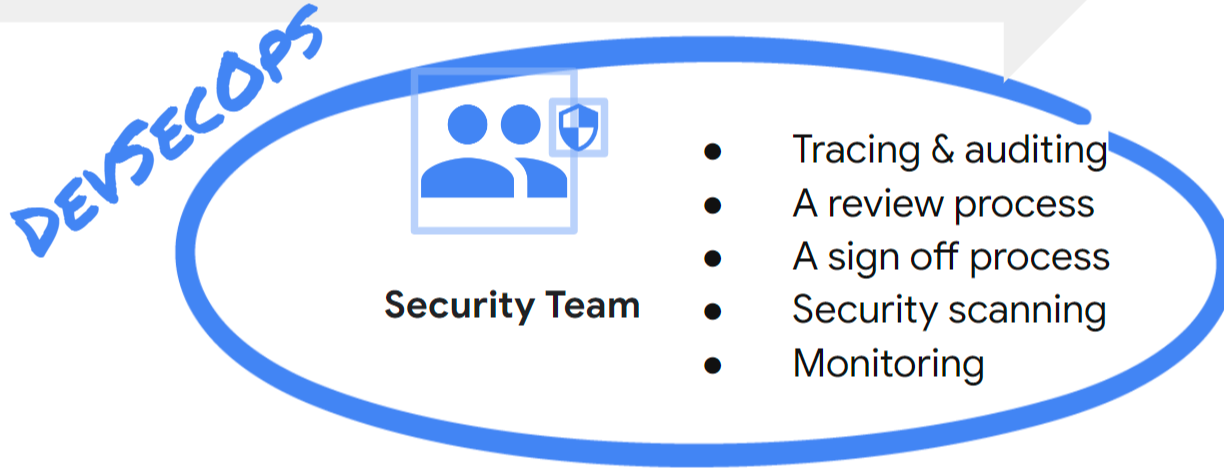
As technology continues to evolve and shape our world, the need for secure software development and deployment practices has become more crucial than ever before. This is where SecDevOps comes into play – an innovative approach to software development that integrates security into the DevOps process.
SecDevOps is a term that combines “Security”, “Development”, and “Operations”. It refers to the practice of incorporating security measures and considerations into the entire software development lifecycle (SDLC) – from planning and coding to testing, deployment, and maintenance.

The integration of security into DevOps is essential because traditional security measures, such as firewalls and intrusion detection systems, are no longer enough to protect against today’s sophisticated cyber threats. SecDevOps provides a proactive approach to security that can help prevent data breaches, mitigate risks, and ensure the integrity of applications.
In this blog post, we will discuss the evolution of DevOps to SecDevOps, the principles of SecDevOps, the benefits and challenges of implementing SecDevOps, and the steps organizations can take to implement this approach successfully. We will also cover best practices and tools for SecDevOps implementation, as well as provide some final thoughts on the importance of SecDevOps.
II. The Evolution of DevOps to SecDevOps
A. Brief history of DevOps
The concept of DevOps originated in 2009 when Patrick Debois coined the term. DevOps is a software development methodology emphasizing collaboration and communication between development and operations teams. It aims to create a culture of shared responsibility and continuous improvement, which leads to faster development cycles and better-quality software.

B. The need for security in DevOps
As organizations started adopting DevOps, they realized that traditional security measures were insufficient to protect against ever-increasing cyber threats. This is because security was often treated as an afterthought, with teams focusing solely on delivering features quickly. As a result, security vulnerabilities were introduced into applications, making them susceptible to attacks.
C. How DevOps evolved to include security (SecDevOps)
As the importance of security became more apparent, organizations started to incorporate it into their DevOps process, giving rise to SecDevOps. SecDevOps aims to integrate these security practices into every stage of the SDLC to create secure software resistant to attacks. In summary, the evolution of DevOps to SecDevOps reflects a growing awareness of the need for secure software development and deployment practices. By integrating security into the DevOps process, organizations can ensure that their applications are secure and their customers’ data is protected. In the next section, we will discuss the principles of SecDevOps in more detail.
III. The Principles of SecDevOps
SecDevOps is based on three fundamental principles that guide security integration into the DevOps process: integration, collaboration, and automation. In this section, we will explore these principles in more detail.
A. Integration of security into the DevOps process
The first principle of SecDevOps is integrating security into every stage of the DevOps process. This means that all security implications should be considered from the initial planning to deployment and maintenance. The goal is to create a culture where security is a shared responsibility across all teams rather than just the responsibility of a separate security team.

Some ways to integrate security into the DevOps process include:
1. Incorporating security requirements into user stories and acceptance criteria
2. Including security testing in the continuous integration/continuous deployment (CI/CD) pipeline
3. Conducting threat modeling and risk assessments to identify potential security vulnerabilities
4. Providing secure coding training and tools to developers
By integrating security into the DevOps process, teams can identify and address any security concerns and issues early in the SDLC, reducing the risk of security vulnerabilities in the final application.
B. Collaboration between security and development teams
The second principle of SecDevOps is collaboration between security teams and development teams. This involves creating a culture of shared responsibility and communication between teams to ensure that security is considered throughout the SDLC. Collaboration is essential because security is no longer the sole responsibility of a separate security team; it is a shared responsibility across all teams.
C. Automated security testing and monitoring
To ensure secure development, strictly adhere to the third rule of SecDevOps: embrace automated security testing and monitoring. Doing so will introduce a layer of protection by having tests implemented in the CI/CD pipeline that can detect any vulnerabilities during earlier stages of production; this helps reduce risk when releasing applications into full operation.
SecDevOps offers organizations a comprehensive approach to security that combines integration, collaboration and automation. When these three core principles are embraced within an existing, DevOps security process, teams benefit from increased application protection against cyber threats while also improving communication between stakeholders. With its many advantages in mind, the next step is considering any obstacles when adopting this approach.
IV. Benefits of SecDevOps
The implementation of SecDevOps has numerous benefits for organizations, ranging from improved security posture to faster time-to-market. In this section, we will explore some of the most significant benefits of SecDevOps.
A. Improved security posture
SecDevOps offers a way to ensure optimal security levels, from the initial development stages all the way through deployment and beyond. By integrating automated testing and monitoring mechanisms at every stage of SDLC you can greatly reduce your risk profile, identifying potential vulnerabilities early on in order to effectively address them before they become major issues. All organizations stand benefit by implementing this comprehensive approach!
B. Faster time to market
Security DevOps can help your team revolutionize the way they work, enabling them to launch products faster and more securely. By identifying security issues before deployment – by integrating into development processes earlier on in the SDLC – teams can avoid costly remediation delays down-the-line. Automation further maximizes speed with no sacrifices made for safety: streamlnining manual tests as well allowing you to meet customer demand even quicker!
C. Improved communication and collaboration between teams
SecDevOps fosters a culture of collaboration between the security and development teams to ensure applications are developed with maximum efficiency, effectiveness, and security. This shared responsibility environment encourages knowledge-sharing which enables both departments to collaborate on strategies that fortify application safety.
D. Improved compliance and risk management
SecDevOps offers teams a powerful way to reduce the risks associated with regulatory compliance. This integrated approach marries security and DevOps, providing an early warning system for potential holes in compliance requirements throughout the SDLC. Automated testing and monitoring also ensure that applications stay compliant before they hit production systems – helping organizations keep their risk exposure low without compromising on performance or speed of delivery.
E. Competitive advantage
For organizations looking to stay ahead of the competition, SecDevOps is a must. By utilizing this strategy, businesses can quickly and securely develop applications that leverage effective security measures while also creating trust with customers through increased loyalty and retention opportunities.
V. Challenges of SecDevOps
While SecDevOps has numerous benefits, its implementation can be challenging. In this section, we will explore some of the significant challenges that organizations may face when implementing SecDevOps.
A. Resistance to change
Incorporating SecDevOps into existing development processes can be a challenge – many organizations have cultures that lack the necessary focus on security. It’s important to raise awareness of its benefits and facilitate change by offering suitable training opportunities, thus enabling teams to make the most out of this innovative approach.
B. Lack of security expertise in development teams
Despite being crucial to the DevOps process, a lack of security expertise among development teams still remains an underemphasized challenge. Organizations can take steps towards mitigating this problem by investing in training and providing tools that equip their developers with proper knowledge and understanding of key security concepts and practices.
C. Managing and monitoring security throughout the entire SDLC
To successfully integrate security into the SDLC, organizations must adopt a shared responsibility across teams and prioritize effective planning and coordination. This ensures that all stages of development – from idea to deployment- include integrated security testing within their CI/CD pipelines for secure end results.
D. Balancing security with speed and agility
Another challenge of SecDevOps is balancing security with speed and agility. While integrating security into the DevOps process can improve the security posture of applications, it can also slow down development cycles if not implemented correctly. Organizations must strike a balance between security and speed to ensure that applications are developed and deployed efficiently.
E. Ensuring compliance with regulatory requirements
SecDevOps can help organizations improve their compliance and risk management practices. However, ensuring compliance with regulatory requirements can be challenging, particularly in highly regulated industries. Organizations must ensure that their SecDevOps processes comply with relevant regulations and standards.
VI. Implementing SecDevOps
Implementing SecDevOps requires careful planning and coordination between security and development teams. In this section, we will explore some of the steps organizations can take to implement SecDevOps successfully.
A. Steps for implementing SecDevOps
1. Define the goals and scope of SecDevOps implementation
2. Establish a cross-functional team that includes security experts
3. Conduct a risk assessment to identify potential security vulnerabilities
4. Identify and prioritize security requirements
5. Incorporate security testing into the CI/CD pipeline
6. Provide security training and tools to development teams
7. Use automation to streamline the development process
8. Monitor security throughout the SDLC
9. Continuously improve and refine SecDevOps processes
B. Best practices for implementing SecDevOps
1. Encourage communication and collaboration between security and development teams
2. Establish clear roles and responsibilities for security and development teams
3. Establish a common language and understanding of security concepts
4. Use metrics to measure the effectiveness of SecDevOps processes
5. Provide regular training and education on security best practices
C. Tools and technologies for implementing SecDevOps
1. Static application security testing (SAST) tools
2. Dynamic application security testing (DAST) tools
3. Container security scanning tools
4. Vulnerability scanning and management tools
5. Continuous integration/continuous deployment (CI/CD) tools
6. Infrastructure as code (IaC) tools
7. Security information and event management (SIEM) tools
VII. Conclusion
SecDevOps is an innovative approach to software development that integrates security into the DevOps process. By incorporating security measures and considerations into every stage of the SDLC, SecDevOps can help organizations develop and deploy secure applications that are resistant to cyber threats.
A. Importance of SecDevOps
SecDevOps is essential because traditional security measures are no longer enough to protect against today’s sophisticated cyber threats. SecDevOps provides a proactive approach to security that can help prevent data breaches, mitigate risks, and ensure the integrity of applications.
B. Final thoughts on SecDevOps
Implementing SecDevOps requires careful planning, coordination, and the use of best practices and tools. By defining the goals and scope of SecDevOps implementation, establishing a cross-functional team, incorporating security testing into the CI/CD pipeline, providing security training and tools to development teams, using automated security tools, and using automation and monitoring to streamline the development process, organizations can successfully implement SecDevOps and improve the security posture of their applications.
C. The future of SecDevOps
As technology and malicious threats evolve, organizations are recognizing the paramount importance of secure development practices for their systems. For these reasons, SecDevOps is a field in which we can expect to see promising growth as it becomes an ever more integral part of creating safe computing environments.
With cyber security threats only continuing to rise, SecDevOps is the key to ensuring organizations are able to develop and deploy secure applications with efficiency. This approach promotes a shared responsibility culture between DevOps teams, allowing for greater collaboration and automation that ultimately leads to better security measures. Embracing SecDevOps will be vital in safeguarding businesses from potential risks as well as protecting their customers’ data going forward.

